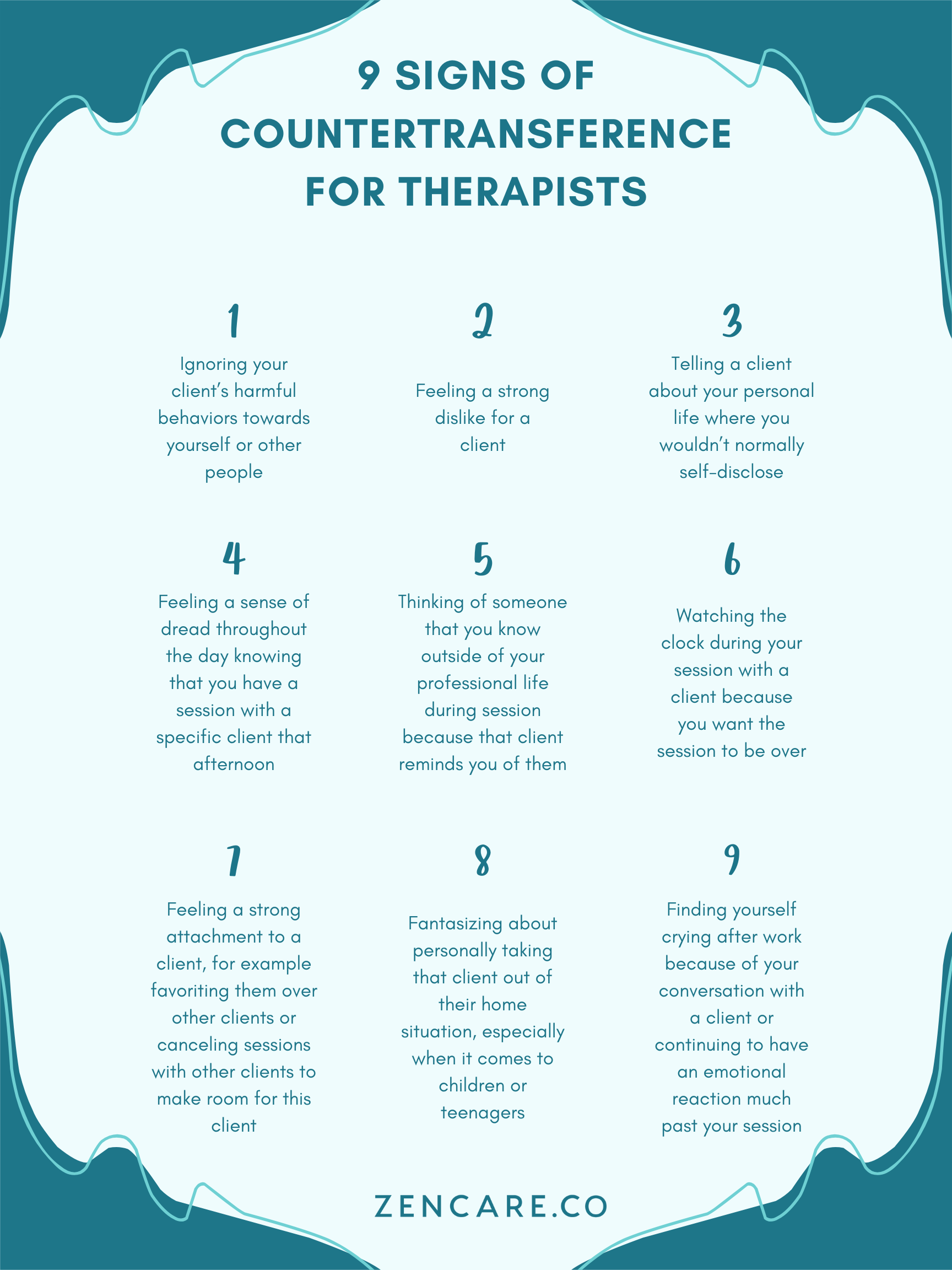Published June 12, 2024 by Zencare Team
Countertransference can have huge impacts on therapists’ work with clients and it’s especially common to experience for therapists just starting out. For this reason, it’s often discussed in clinical supervision conversations and continuing education courses.
Whether you’re on a provisional license or your private practice is already well-established, learning more about countertransference and how to avoid its negative impacts on clinical care is important. Read on to gain a sound understanding of countertransference and how it might show up in your client sessions.

What is countertransference?
Countertransference occurs when a therapist projects their own emotions onto a client, letting those emotions shape their relationship with clients. The term “countertransference” originated with Sigmund Freud, whose prominence as a psychoanalyst led not only to many clinical programs integrating his concepts into their coursework but also to the general public engaging with his ideas through articles, books, and media.
Countertransference happens unconsciously – unless therapists take a moment to think through their reactions to clients or engage in clinical supervision. Because therapists experiencing countertransference bring their own reactions to the client or the client’s actions, they might find themselves stepping outside of their role as the therapist, when can have significant consequences.
While in the early 1900s Freud suggested that countertransference was maladaptive and even harmful for clients – with the therapist projecting their own unresolved conflicts onto their clients – by mid-century, other therapists believed that countertransference could be used skillfully to enhance the client’s therapeutic outcomes.
Transference vs. Countertransference
Transference is the mirrored psychological concept where the client projects their emotions or life experiences onto their therapist. For example, their therapist might remind them of their sibling, which can get in the way of them engaging with their therapist on neutral grounds.
Transference is also an unconscious process that generally happens without the client or the therapist realizing that it’s taken a seat at the table. However, unlike countertransference, which is mostly regarded as a barrier to client outcomes, transference belongs in the conversation and can be used to further a client’s therapy goals. When an expert therapist utilizes a client’s transference, they can help them become aware of their reactions to certain types of people or conversations, which in turn can help them engage in healthier dynamics with others.
Is countertransference helpful or harmful?
Most therapists understand countertransference to be harmful when it appears in their sessions. However, countertransference is inevitable, as all therapists bring their whole lives with them into their sessions – their past experiences don’t wait outside of the door while they’re working with clients. While natural, countertransference is something to be taken seriously by therapists and can become harmful to the client if not addressed.
That said, some highly trained therapists leverage their countertransference to help their clients. Countertransference, in certain cases, can be a realistic representation of how other people react to their client. For example, if a therapist finds that their client’s aversion to talking about their emotions challenging, they might conclude that other people in the client’s life also finds it challenging – and that this might be one factor behind the client's inability to maintain friendships.
Understanding a therapist’s countertransference can also help them become a better therapist, as they’ll be more attuned to their own reactions in future sessions. This can limit the impacts of harmful countertransference and difficult sessions, leaving more space for supportive, empathetic conversations with clients.
Types of countertransference
There are four types of countertransference, as established by therapists:
- Subjective. Subjective countertransference happens when the therapist’s own experiences influence their reactions when talking to a client. They might have previously experienced a similar situation to the client, which leads them to avoiding talking about certain parts of that experience so as not to become distressed themselves. This is a potentially harmful type of countertransference that can have huge implications for a client’s experience of therapy.
- Objective. Objective countertransference describes when a therapist’s reactions to a client’s maladaptive behaviors – such as becoming abrasive or angry when stressed out – can be generalized to other people’s reactions to that individual. As described above, this can be a helpful experience when handled carefully by the therapist, as they can get an objective glimpse into the client’s world outside their office.
- Positive. Positive countertransference is when the therapist becomes overly supportive of their client to the point where it’s not helpful for their client. When therapists position themselves as “friends” to their clients rather than mental health professionals who are providing a service, they can end up crossing boundaries. While there’s a time and place for self-disclosure, therapists who experience positive countertransference might end up holding their clients back from growth or healing.
- Negative. Lastly, negative countertransference occurs when therapists become overly critical of their clients because of their own discomfort. They might implicitly reject the client or appear bored in their sessions, which can be extremely detrimental for the client.
Signs of countertransference
Because of the importance of identifying countertransference when working with clients, most clinical education programs teach therapists what to look out for in case they’re experiencing countertransference.
Here are a few signs that countertransference is happening, which might indicate that it’s time for a clinical supervision session:
- Feeling a strong dislike for a client
- Feeling a sense of dread throughout the day knowing that you have a session with a specific client that afternoon
- Thinking of someone that you know outside of your professional life during session because that client reminds you of them
- Feeling a strong attachment to a client, for example favoriting them over other clients or canceling sessions with other clients to make room for this client
- Telling a client about your personal life where you wouldn’t normally self-disclose
- Ignoring your client’s harmful behaviors towards yourself or other people
- Fantasizing about personally taking that client out of their home situation, especially when it comes to children or teenagers
- Finding yourself crying after work because of your conversation with a client or continuing to have an emotional reaction much past your session
- Watching the clock during your session with a client because you want the session to be over
These signs, on their own, don’t necessarily mean that countertransference is occurring or negatively impacting the client. However, unchecked, these signs can lead to harmful outcomes for the client.
Examples of countertransference
There are many examples of countertransference, as each therapist has their own experiences from which to draw when it comes to their relationships with clients.
One example of countertransference might be when a therapist who just recently went through a divorce encourages their client to also get divorced, offering personal advice when their role should be to simply provide an empathetic space for the client to talk about what’s happening in their relationship.
Another example might be when a client reminds their therapist about their childhood best friend, which leads the therapist to becoming emotionally attached to that client and unable to set the boundaries they need to improve their mental health.
Some therapists realize that they’re experiencing countertransference when they’re overly protective over a specific client, snapping at other members of the client’s care team when suggestions are made that might interfere with that client’s therapy. Other therapists become aware of their countertransference when they feel an intense resentment toward a client without having a tangible explanation.
How to manage countertransference as a therapist
To best manage countertransference as a therapist, attending regular clinical supervision sessions is a great way to talk about your relationships with your clients and how your own reactions play out during your sessions. Clinical supervisors can point out biases or unfair judgments and make suggestions on how to handle reactions during session to avoid harming the client.
Countertransference is bound to happen for therapists, and it’s nothing to be ashamed about – it's natural and largely unavoidable. Even the most experienced therapists at times struggle with countertransference, however they see countertransference as an opportunity to explore their clinical work and to learn what to do next time to avoid harming their clients.
Clinical supervision sessions – as well as group supervision or working with a mentor – can help therapists grow their self-awareness and reflect on what’s happening internally for them during sessions. They can also talk through anything that’s holding them back from fully supporting a client or discuss how to set better boundaries in their sessions when they’re inclined to become attached to certain clients.
Countertransference is an essential psychological concept for therapists to learn about and to keep top-of-mind when they’re working with clients. For therapists just starting out, it doesn’t have to be scary, especially if they have strong relationships with their clinical supervisors so they can reach out and have a conversation about what’s happening.
